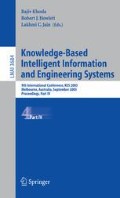Abstract
Classifiers are often data dependent as they perform better on one type of data, but fail to perform well for another data set. There is a need for robust classification algorithms which exhibit performance stability for multiple types of data. This problem can be addressed if different classifiers are fused to identify a particular class. In this paper, we have implemented the idea of classifier fusion using six different classifiers to classify the microarray gene expression data of breast cancer patients. The paper uses two classifier fusion models: majority voting and random bagging to improve the accuracy of the classifiers. Our experimental results have shown that the new proposed classifiers fusion methodology have outperforms single classification models.
Access this chapter
Tax calculation will be finalised at checkout
Purchases are for personal use only
Preview
Unable to display preview. Download preview PDF.
References
Miki, Y., et al.: A strong candidate for the breast and ovarian cancer susceptibility gene BRCA1. Science 266(5182), 66–71 (1994)
Perou, C.M., et al.: Molecular portraits of human breast tumours. Nature 406, 747–752 (2000)
Hedenfalk, I., et al.: Gene-expression profiles in hereditary breast cancer. N. Engl. J. Med. 344(8), 539–548 (2001)
Golub, T.R., et al.: Molecular classification of cancer: class discovery and class prediction by gene expression monitoring. Science 286, 531–537 (1999)
Ross, D.T., et al.: Systematic Variation in Gene Expression Patterns in Human Cancer Cell Lines. Nature Genetics 24, 227–234 (2000)
Radmacher, et al.: A Paradigm for Class Prediction using Gene Expression Profiles. J. Comp. Bio. 9(3), 505–511 (2002)
Cooper, C.S.: Applications of microarray technology in breast cancer research. Breast Cancer Res. 3(3), 158–175 (2001)
Heilhaber, et al.: Bayesian Estimation of Fold-Changes in the Analysis of Gene Expression: The PFOLD Algorithm. J. Com. Bio. 8(6), 585–614 (2001)
David, et al.: The limit fold change model: A practical approach for selecting differentially expressed genes from microarray data. BMC Bioinformatics 3, 17 (2002)
Welcsh, et al.: BRCA1 transcriptionally regulates genes involved in breast tumorigenesis. PNAS 99(11), 7560–7565 (2002)
Dobbin, K., Simon, R.: Comparison of microarray designs for class comparison and class discovery. Bioinformatics 18(11), 1438–1445 (2002)
Wright, G., Simon, R.: The random variance model for finding differentially expressed genes. Bioinformatics 19, 2448–2455 (2003)
Baldi, P., Long, A.D.: A Bayesian framework for the analysis of microarray expression data: regularized t-test and statistical inferences of gene changes. Bioinformatics 17, 509–519 (2001)
Dudoit, S., Fridlyand, J., Speed, T.P.: Comparison of discrimination methods for the classification of tumors using gene expression data. Journal of the American Statistical Association 97, 77–87 (2002)
Stone, M.: Cross-validatory choice and assessment of statistical predictions. Journal of the Royal Statistical Society, B 36(1), 111–147 (1974)
Vapnik, V., Chapelle, O.: Bounds on error expectation for SVM. In: Smola, A.J., Bartlett, P.L., Schölkopf, B., Schuurmans, D. (eds.) Advances in Large Margin Classifiers, ch. 14, pp. 261–280 (2000)
Chapelle, C., Vapnik, V., Bousquet, O., Mukherjee, S.: Choosing multiple parameters for support vector machines. Machine Learning (2002)
Freund, Y., Schapire, R.E.: Experiments with a new boosting algorithm. In: Proceedings of the Thirteenth International Conference “Machine Learning”, pp. 148–156 (1996)
Breiman, L.: Half&Half bagging and hard boundary points. Technical report 534, Statistics Departament, University of California, Berkeley, www.stat.berkley.edu/users/breiman (1998)
Freund, Y., Schapire, R.E.: A decision-theoretic generalization of on-line learning and an application to boosting. Journal of Computer and System Sciences 55, 119–139 (1997)
LeBlanc, M., Tibshirani, R.: Combining estimates in regression and classification. J. Amer. Statist. Assoc. 91, 1641–1650 (1996)
Author information
Authors and Affiliations
Editor information
Editors and Affiliations
Rights and permissions
Copyright information
© 2005 Springer-Verlag Berlin Heidelberg
About this paper
Cite this paper
Raza, M., Gondal, I., Green, D., Coppel, R.L. (2005). Classifier Fusion to Predict Breast Cancer Tumors Based on Microarray Gene Expression Data. In: Khosla, R., Howlett, R.J., Jain, L.C. (eds) Knowledge-Based Intelligent Information and Engineering Systems. KES 2005. Lecture Notes in Computer Science(), vol 3684. Springer, Berlin, Heidelberg. https://doi.org/10.1007/11554028_121
Download citation
DOI: https://doi.org/10.1007/11554028_121
Publisher Name: Springer, Berlin, Heidelberg
Print ISBN: 978-3-540-28897-8
Online ISBN: 978-3-540-31997-9
eBook Packages: Computer ScienceComputer Science (R0)

